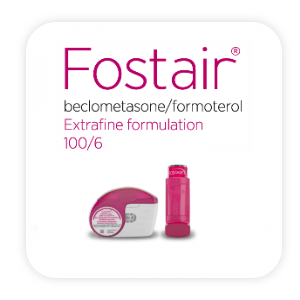Poor asthma control is a major problem in the UK1-3
Many factors can contribute to poorly controlled asthma – also known as ‘difficult asthma’. It can result from poor adherence to treatment (i.e. not using an inhaler enough or as prescribed), incorrect inhaler technique, other simultaneous medical issues or even a wrong diagnosis.2
Definition of poorly controlled asthma2
| National Institute for Health and Care Excellence (NICE) | The European Respiratory Society (ERS) |
|
|
In the UK, overusing a SABA is a clear sign a patient has poor asthma control.1 SABA overuse is defined as use more than three SABA inhalers over 12 months.4,5 It is also linked to less frequent use of inhaled corticosteroids (ICS) than needed.5 Both of these are known causes of avoidable asthma exacerbations and asthma-related deaths in the UK;4 they are also related to more primary care visits and hospital consultations.5
At 58% prevalence in moderate-to-severe asthma patients, the UK has the highest rate of SABA overuse in Europe.5 More than 80% of the total SABA prescriptions for asthma are written for SABA overusers, which is equivalent to over 9.2 million prescriptions in a year.3 A combination of ICS and a long-acting β2-agonist (LABA) may be a user-friendly option to tackle SABA overuse and improve adherence.4
Read more about tackling SABA overuse in asthma patients.
Could MART help tackle poor asthma control?
Maintenance and reliever therapy (MART) describes when a patient is prescribed an ICS/LABA as a maintenance dose and in addition, as a reliever when they experience symptoms. This means a preventer and a reliever medicine are combined in the same inhaler.6
In a quality improvement programme (QIP) study in the UK (n=2,473), switching to MART to reduce SABA overuse was considered appropriate for over half (63.5%) of the asthma patients who needed a treatment change (n=633).7
MART therapy has been linked to better treatment adherence, patient satisfaction,8 and a lower risk of asthma exacerbations and hospitalisations compared with other treatment plans9,10
Other benefits of MART therapy include:6,9,11-15,17-18
| For your patients | For the NHS |
|
|
Who could benefit from MART?
For every patient, successful delivery of treatment into the lungs depends on both adherence and proper use of their inhaler.14 If they don’t use their inhaler(s) properly, and in turn don’t see the benefits they expect, they could stop using them altogether. This could begin a cycle that leads to poorer health outcomes.15
The difficulties with adherence and inhaler technique become more complicated when several devices with different instructions have to be used. Even with training, errors can still happen for a few reasons, including:14,15
- age − problems with hearing, sight, understanding and remembering instructions properly
- low health literacy − unfamiliarity with health-related terminology can make it difficult to fully understand inhaler instructions
- language barriers
- physical challenges, for example poor co-ordination (e.g. pMDI vs DPIs)
- personal preferences around devices and device types.
Concerningly, using multiple inhalers is related to more user errors, lower adherence, a higher chance of stopping inhaler use and worse health outcomes than using a single inhaler.14,15
“The use of combination inhalers should be encouraged. Where long-acting beta agonist (LABA) bronchodilators are prescribed for people with asthma, they should be prescribed with an inhaled corticosteroid in a single combination inhaler.”1
The National Review of Asthma Deaths (NRAD), Royal College of Physicians.
In MART, the preventive and reliever medication are combined into a single device.16
Currently, MART for asthma is recommended by several guidelines.6,11,16
| Guideline | MART recommendation |
| The British Thoracic Society/Scottish Intercollegiate Guideline Network (BTS/SIGN) | Adults with a history of asthma attacks on medium dose ICS or ICS/LABA6 |
| The Global Initiative on Asthma (GINA). | Adults in Steps 3−5* of asthma treatment, and adults who:11
|
*Moderate to severe asthma that has been already treated for the modifiable causes of symptoms.19
Helping patients get the most from MART
It is known that patients’ own preferences and ideas about a treatment can affect how well they respond to it.15 This means that choosing the right inhaler for the right patient, and doing this in consultation with patients directly, may be as critical as the treatment itself.14
The general user experience, including how simple or convenient it is to use an inhaler, may matter to patients.15 In fact, satisfaction with an inhaler is related to:14
- treatment adherence
- fewer asthma exacerbations
- fewer hospital visits
- improved quality of life.
As satisfaction is not necessarily linked to better inhaler technique, it is extremely important to involve patients in the decision-making and ensure they understand the choice of inhaler being prescribed to them personally. It is key for people to understand how and why a device should be used correctly and why it is needed in the first place.14 This may mean discussing any fears about side effects or a treatment not working.15
Each person has their own unique characteristics and needs, and they can often overestimate their ability to use an inhaler properly.14 Joint decision-making plus education has been shown to improve patient outcomes.15










